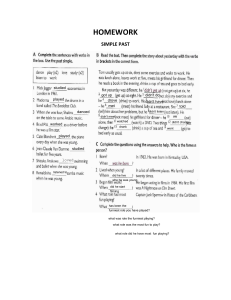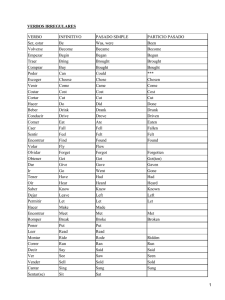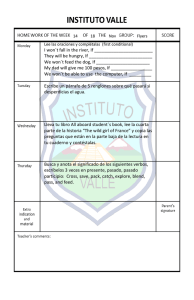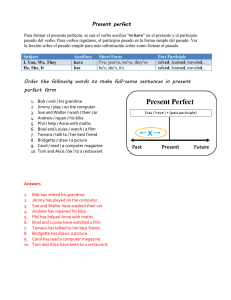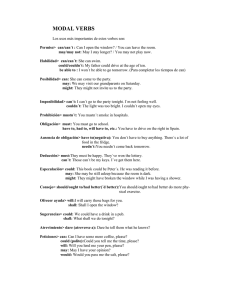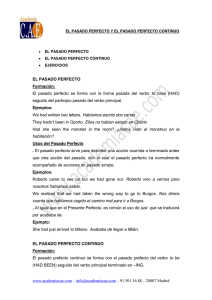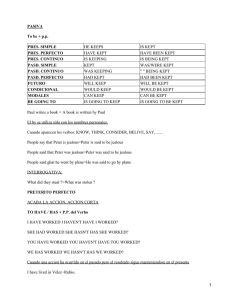Past Perfect Ref.T (3)
Anuncio
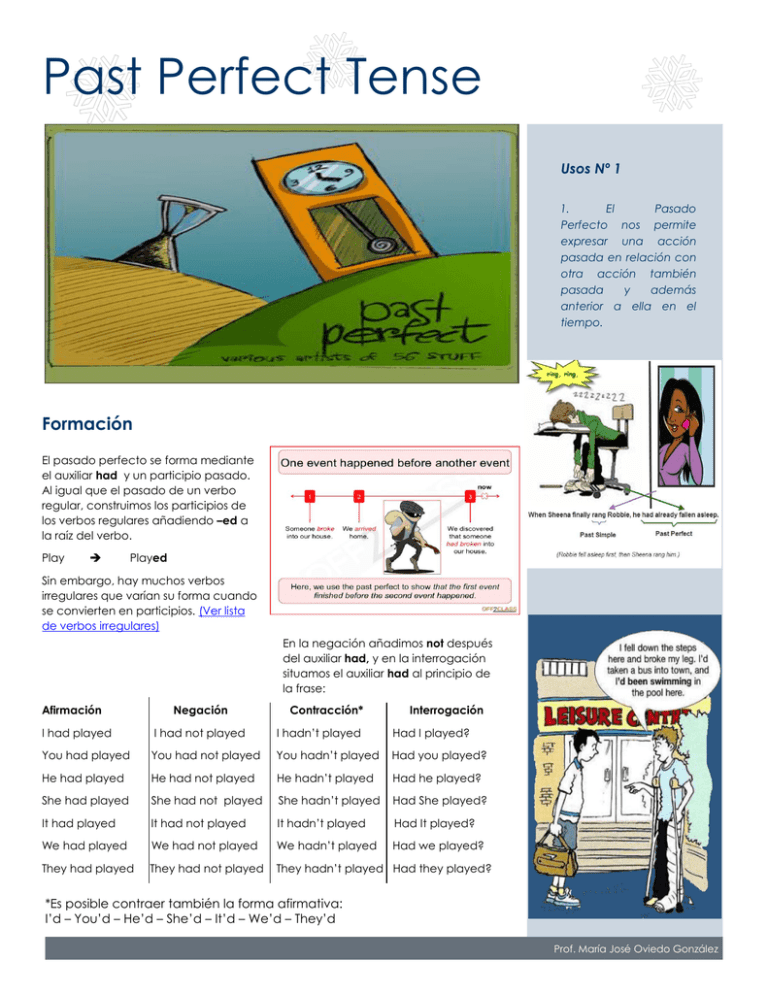
Past Perfect Tense Usos Nº 1 1. El Pasado Perfecto nos permite expresar una acción pasada en relación con otra acción también pasada y además anterior a ella en el tiempo. Formación Happy holidays from our family to yours! El pasado perfecto se forma mediante el auxiliar had y un participio pasado. Al igual que el pasado de un verbo regular, construimos los participios de los verbos regulares añadiendo –ed a la raíz del verbo. Play Played Sin embargo, hay muchos verbos irregulares que varían su forma cuando se convierten en participios. (Ver lista de verbos irregulares) En la negación añadimos not después del auxiliar had, y en la interrogación situamos el auxiliar had al principio de la frase: Afirmación Negación Contracción* Interrogación I had played I had not played I hadn’t played Had I played? You had played You had not played You hadn’t played Had you played? He had played He had not played He hadn’t played Had he played? She had played She had not played She hadn’t played Had She played? It had played It had not played It hadn’t played Had It played? We had played We had not played We hadn’t played Had we played? They had played They had not played They hadn’t played Had they played? *Es posible contraer también la forma afirmativa: I’d – You’d – He’d – She’d – It’d – We’d – They’d Prof. María José Oviedo González Uso Nº 2 Podemos utilizar el pasado perfecto en el estilo ) indirecto con verbos tales como To tell (decir), To explain (explicar), To wonder (preguntarse) Ej: He wondered who had sent him the flowers (Se preguntaba quién le había enviado las flores) She told us that she had only slept for two hours ( Nos dijo que había dormido solamente dos horas) Describe esta imagen usando el pasado perfecto:__________ _____________________________ _____________________________ _____________________________ _____________________________ _____________________________ _____________________________ El Pasado Simple y el Pasado Perfecto: A menudo el uso del pasado perfecto o del pasado simple es indistinto: I went to check my e-mail after they had left (Cuando salieron, fui a mirar mi correo electrónico) I went to check my e-mail after they left (Fuí a mirar mi correo después de que salieron) Sin embargo, a veces puede cambiar el significado de la frase: When Sally arrived he had left the room Cuándo Sally llegó, él ya había salido de la habitación (Cuándo Sally llegó el ya no estaba en el cuarto) When Sally arrived he left the room Cuándo Sally llegó, el salió de la habitación (Se fue en el mismo instante que llegó Sally) Nota: El uso de varios verbos en el pasado simple conlleva la idea de acciones sucesivas. En cambio, el pasado perfecto indica que una acción ha ocurrido con anterioridad a otra: He went to bed at twelve thirty. He had already tidied his room. Se fue a la cama a las doce y media. Ya había arreglado su cuarto. Además, podemos emplear el pasado perfecto para referirnos a sueños o ilusiones no realizadas: I had hoped to finish it by that night but it was impossible Esperaba terminarlo aquella noche pero era imposible Página 2 Describe esta imagen. No olvides usar el Pasado Perfecto: ________________________________ ________________________________ ________________________________ ________________________________ ________________________________ ________________________________ ________________________________ _ Prof. María José Oviedo González Colegio Nstra. Sra. Del Rosario del Fátima. Boconó. 5 Año Referente Teórico Nº3 Activity Nº 1 Activity Nº 2 Link to YouTube Video, ‘Mr. Bean Making a Sandwich’* Please, click here and look at this https://www.youtube.com/watch?v=jtqp uYvOfHY https://www.youtube.com/watch?v=My2myUF1Ax8 PAST PERFECT TENSE Trabajo en Pareja: Full Names:_________________ _________________________ _________________________ _________________________ Date:___________________ Follow the instructions given in class by the teacher for the next activity: Write 5 sentences using Past Perfect (5p) 1.________________________________________________________________________________________ 2.________________________________________________________________________________________ 3.________________________________________________________________________________________ 4.________________________________________________________________________________________ . 5.________________________________________________________________________________________ Write 5 sentences using Past Perfect and Simple Past. (5p) 1.________________________________________________________________________________________ 2.________________________________________________________________________________________ 3.________________________________________________________________________________________ 4.________________________________________________________________________________________ 5.________________________________________________________________________________________ Discussion: Social Etiquette What is acceptable social behavior in the following situations: lunch by yourself in a public place, personal party with friends or family, business dinner, banquet. Is there any acceptable behavior in one situation that is unacceptable in another? What advice would you give to Mr. Bean on social etiquette? What advice would you give to the businessman sitting next to Mr. Bean? What is your opinion about this (in English)? (10p) __________________________________________________________________________________________ __________________________________________________________________________________________ __________________________________________________________________________________________ Leyenda que describe una imagen o un gráfico. __________________________________________________________________________________________ __________________________________________________________________________________________ __________________________________________________________________________________________ __________________________________________________________________________________________ ____________________ ___________________ Signature Student 1 Signature Student 2 Página 3 Prof. María José Oviedo González.
